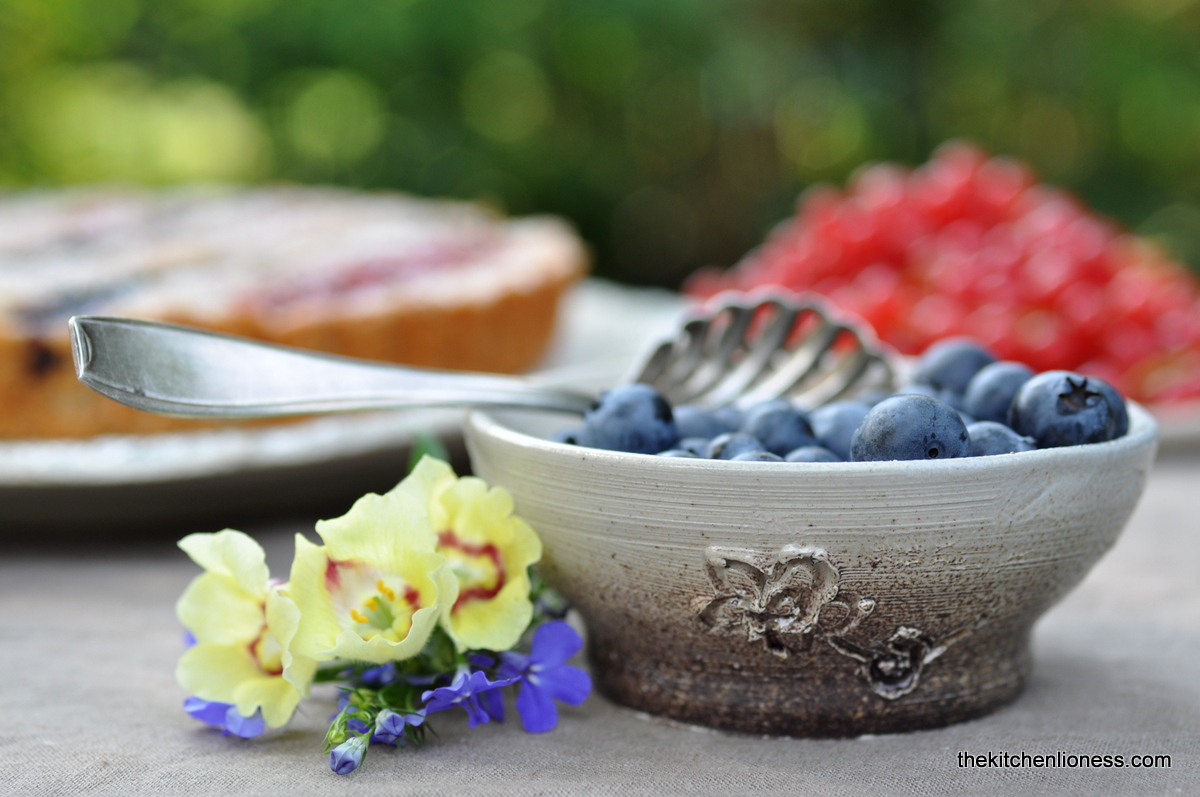Always on the lookout for recipes with different kinds of flour, I came across this beauty of a late summer cake recipe by Melissa Clark – a pretty as a picture Buckwheat Berry Stirped Cake. Melissa points out that „the combination of buckwheat and whole wheat flour gives this deeply buttery cake a character that is nutty, rich and complex, while a little almond flour adds tenderness“. And, on a weeknight, it is nice to go with something simple yet stunning for dessert – like this amazing cake.
And baking this cake in a tart pan with removable bottom instead of a cake pan allows the colorful berries to rest on top of the batter rather than sink to the bottom. I found the berry stripes simply striking and opted for late season redcurrants and blueberries here. You should definitely feel free to create any design you like. And do remember to serve this on the same day as you bake it, preferably within 6 hours of baking. It is true, because this is a rather moist cake, it does not keep that well overnight.
Buckwheat actually comes from the seeds of a plant related to rhubarb and is neither related to wheat, nor, technically, a grain. It is usually found in ground form, but can also be bought as wholegrain groats, cracked as flakes or cereal, and in processed foods such as pasta. Delicious in salads, it lends itself well to being mixed with other pseudo-grains such as quinoa. Buckwheat flour – or farine de sarrasin in French – is in itself always gluten-free. It can be added to pancakes, muffins, rustic porridges, pierogi dumplings, blinis, galettes, fruit flans and soba noodles. The fine-textured flour is grey-ish, speckled with black.
Buckwheat has an intense, earthy, slightly nutty and smoky flavor. Healthwise, buckwheat is rich in vitamins and minerals. Buckwheat flour is available in specialist stores, Polish or Russian grocers, some supermarkets and most health food stores and it is pretty easy to find online. And note that as buckwheat contains about double the oil of most cereals, which affects its shelf life, once opened, it should be kept it in an airtight container in a cool, dry place.
Some cooks and foodies assert that „buckwheat is an acquired taste. But once you've acquired it, you'll want it all the time“. Andf I believe they are right.
Buckwheat Berry Striped Cake
(recipe inspired by the wonderfully talented Melissa Clark)
Ingredients for the Batter
- ⅓ cup/40 grams almond flour (or grind natural almonds yourself)
- ⅓ cup/45 grams AP (plain) flour
- ⅓ cup/45 grams whole wheat flour
- ¼ cup/30 grams buckwheat flour
- ½ tsp Ceylon cinnamon (which I believe goes so well with the flours used in this recipe)
- ½ tsp baking powder
- ½ tsp fine sea salt
- 1 stick/114 grams unsalted butter, softened, more for buttering the tart pan
- ½ cup/100 grams superfiine (caster) baking sugar
- 1 ½ tsp pure vanilla sugar
- 1 egg (L), free range or organic
- ¼ cup/60 milliliters buttermilk, sour cream or whole milk yogurt (I used natural yogurt)
- 1 cup mixed berries, such as blueberries and redcurrants
Ingredients for the Topping
- 1 tspn raw turbinado sugar
- confectioners’ sugar, for serving
- softly whipped, lightly sweetened whipped cream or crème fraîche (optional)
Preparation
- Heat oven to 190° C (375°F) and butter a 25 cm (10-inch) tart pan with a removable bottom.
- Line the bottom with a round of baking parchment, and butter that as well.
- In a large bowl, whisk together almond, all-purpose, whole wheat and buckwheat flours, baking powder, cinnamon and salt.
- Using an electric mixer, beat together butter, sugar and vanilla sugar until pale and fluffy, about 3 minutes.
- Beat in egg, scraping down sides of bowl as necessary.
- Beat in buttermilk or yogurt. (The mixture will look curdled, and that is fine - as soon as you add the dry ingredients, the batter will smooth out again.)
- Stir the flour mixture into the butter mixture until just combined.
- Scrape batter into prepared tart pan, smoothing and leveling the top.
- Place berries on top of batter and sprinkle with turbinado or granulated sugar.
- Bake until golden and a toothpick inserted in the center comes out clean, 25 to 30 minutes.
- Cool to room temperature on a wire rack and unmold.
- Sprinkle with confectioners’ sugar, serve as is or with whipped cream or crème fraîche.
Honestly, I cannot wait to make this cake again. I will experiment with other fruit and let you know how that turns out. We took it to one of our picnics and it transported so well, not really needing anything but a slight dusting of confectioners´ sugar on top – that day we skipped the lightly whippped cream or the crème fraîche as we were outside but having served this at home as well, I can attest to the fact that it tastes heavenly with a bit of cream on the side…and this cake is a wonderful alternative to those buckles, grunts, tarts and galettes that are all utterly delicious but that miss that elegant and different look of this beauty of a cake. Let´s not forget to mention the texture of this cake, it is very moist, it literally melts in your mouth and it is ever so slightly crisp at the edges - truly a cake that the Britsih would refer to as a "damp cake", shortly, my kind of cake.























